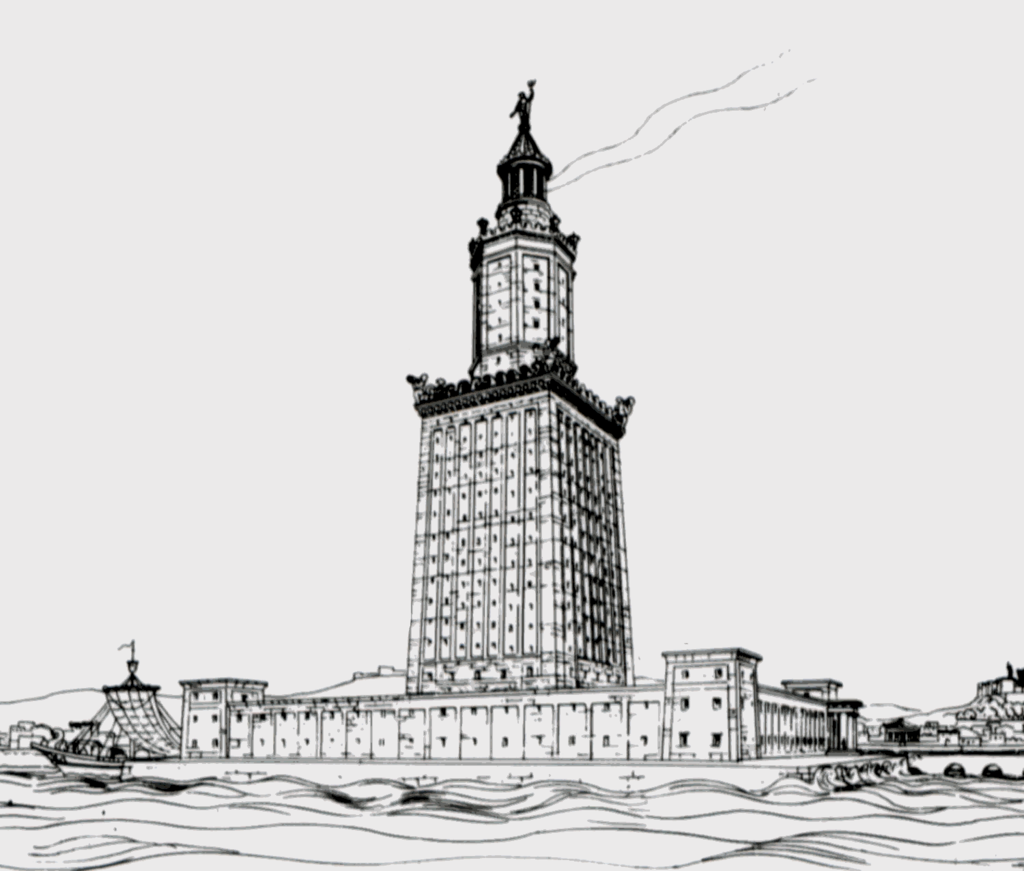Two of the world’s longest serving lighthouses are closely related. The original lighthouse was the Pharos of Alexandria. This lighthouse was constructed in the third century BCE by Ptolemy 1st and is counted among the Seven Wonders of the Ancient World. The second is the ‘Tower of Hercules’. This is the oldest known working lighthouse. It has an Roman origin, built in the 1st century CE, on a peninsula about 2.4 km from the centre of A Coruña, Galicia, in north-western Spain. So, what’s the connection?
Pharos of Alexandria

Following his conquest of Egypt, Alexander the Great founded the city of Alexandria, in331 BCE, as his new capital, and a showplace linking Greek and Egyptian culture. The presence of a natural harbor and a nearby supply of fresh water combined with an already existing colony of Macedonians made the selection of the site, an easy choice.
Alexandria was one of the world’s first planned cities. From its Gate of the Sun to its Gate of the Moon, temples and palaces lined its spacious streets. The city witnessed the romance of Julius Caesar and Cleopatra, the genius of the greatest mathematicians, and boasted the world’s first and probably greatest public library (see: The Great Library of Alexandria – The first Google?). The development of Alexandria into a centre of world trade continued under the Ptolemaic dynasty.
Pharos was a small island located off the coast of Alexandria. As part of the harbour development, Alexandria and Pharos were connected by a mole spanning more than 1,200 metres (0.75 miles), called the Heptastadion. The east side of the mole became the Great Harbour, and on the west side lay the Royal Harbour. The Pharos was built at the extreme Western end of the island, marking shoals and the entrance to the harbour, by the architect Sostratus of Cnidus, a friend of the Ptolemaic kings. A second, shorter causeway ran from the end of the island to the rock on which the Pharos was built.
According to the sources, the 135-meter-high lighthouse was built between c. 300 – 280 BCE, during the reigns of Ptolemy I and II. The structure has three stages, all sloping slightly inward; the lowest was square, the next octagonal, and the top cylindrical. A broad spiral ramp led to the top, where a fire burned at night and for many years a mirror reflected sunlight during the day. The main building materials were blocks of limestone and granite.
How the fire was maintained during the lighthouse’s 17 centuries of operation is uncertain wood was always in short supply and expensive, oil or naphtha are possible alternatives. There appears to have been a cadre of trained operators, who lived in the Pharos and were responsible for the logistics and uninterrupted operation of the light as the rulers of Egypt changed from the Ptolemaic dynasty, to the Romans, to the Arabs.
The lighthouse was severely damaged by three earthquakes between 956 and 1323 CE, eventually becoming an abandoned ruin. The Salten of Egypt converted base of the tower into a fort in 1480, reusing some of the stoned form the original construction.
The ‘Tower of Hercules’ – Spain
The Tower of Hercules is the oldest known working lighthouse. The tower was built in the 1st century CE, on a peninsula about 2.4 km from the centre of A Coruña, Galicia, in north-western Spain. It was built by the architect Gaius Sevius Lupus, from Aeminium in the province of Lusitania (present-day Coimbra, Portugal) using the original plans of the Pharos of Alexandria. The tower has been in constant use since the 2nd century CE and is considered to be the oldest extant lighthouse.
The original tower was shorter and wider than the one in the photograph by Alessio Damato. The original 34-metre (112 ft) Roman core was surrounded by a spiral ramp. Then in 1788, the tower core was given a neoclassical restoration, including a new 21-metre (69 ft) fourth story. This restoration was undertaken by naval engineer Eustaquio Giannini and was finished in 1791. His work protected the central core of the original Roman monument while restoring its technical functions.
Within, the much-repaired lighthouse, Roman and medieval masonry may be inspected, including a cornerstone with the inscription MARTI AVG.SACR C.SEVIVS LVPVS ARCHITECTVS ÆMINIENSIS LVSITANVS.EX.VO, identifying the architect and dedicating the structure to Mars, the Roman god of war.
Final thoughts
The longevity of both of these structures, and many of the more modern lighthouses built in the 18th century are a testament to the durability of a well-constructed stone structure. In an age where minimizing the embedded carbon in structures is becoming increasingly important, should we be shifting back to durable stone in preference to concrete with its effective life-span measured in decades?
For more on the history of construction management see: https://mosaicprojects.com.au/PMKI-ZSY-005.php#Bld


Good Topic. Best Scope 3 Emissions Management Software
Pingback: Every decision you make, every action you take has a carbon footprint | Mosaicproject's Blog